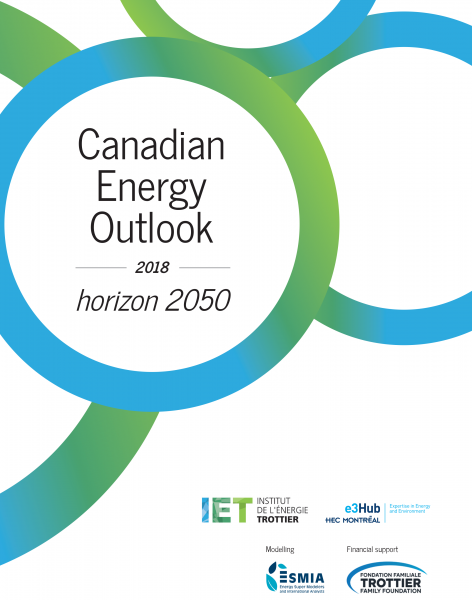Modelling to meet the energy challenge by 2050
 On September 19, the Institut de l’énergie Trottier of Polytechnique Montréal and Pôle e3 of HEC Montréal launched Canadian Energy Outlook 2018. Produced with the collaboration of ESMIA Consultant, this report projects the evolution of Canada’s energy production and consumption to 2050, comparing four greenhouse gas (GHG) reduction scenarios with a baseline scenario. It is the first report of this kind covering Canada in over a decade.
On September 19, the Institut de l’énergie Trottier of Polytechnique Montréal and Pôle e3 of HEC Montréal launched Canadian Energy Outlook 2018. Produced with the collaboration of ESMIA Consultant, this report projects the evolution of Canada’s energy production and consumption to 2050, comparing four greenhouse gas (GHG) reduction scenarios with a baseline scenario. It is the first report of this kind covering Canada in over a decade.
The energy sector, at the core of Canada’s economic development and accounting for nearly 7% of its GDP, is very important for the country’s future. However, the future of this field is marked by provincial and federal climate commitments that are often incompatible, as shown by comparing the impact of various objectives and targets.
The authors of this new Energy Outlook therefore hope their work will contribute to enlighten policy and investment decision-making. The scenarios explored in the report allow evaluation of the cost and impact of various trajectories seeking to achieve the medium and long-term objectives for reduction of GHG emissions. “We examine the transformations resulting both at the national level and province by province, accounting for the major differences between their energy profiles,” points out the energy research specialist and co-author of the report, Simon Langlois-Bertrand.
In the long term, Canada has the potential to transform itself
The modelling results show that it is possible for Canada to achieve the ambitious objective of reducing energy-related GHG emissions by 80% by 2050, without affecting consumers’ access to energy. However, to do this, a major transformation is necessary.
For example, several scenarios point to an amplified demand for electricity, which will result in massive investments to generate, distribute and use this form of energy. Parallel to this, the oil and gas sector will have to reduce its emissions and even, in some cases, its production level. This situation will oblige some provinces to reconfigure part of their economy and retrain their workforce.
On the other hand, the greatest projected reduction of energy needs concerns the transportation sector. This is explained by large gains in energy efficiency, particularly related to the increased use of electric engines in replacement of internal combustion engines.
A trajectory that does not meet its targets
While the various energy trajectories analyzed in this exercise suggest that the Canadian economy could sustain and even benefit from a more efficient fight against climate change, the current measures are clearly insufficient. Indeed, it is already established that Canada will not be able to honour its 2030 objective of reducing the emission level by 30% in relation to 2005.
The current trajectory also does not match with the 80% GHG emission reduction target for 2050, and the intermediate objectives of the federal and provincial governments. These will be missed by a wide margin, unless a significant correction is made throughout the Canadian economy.
The necessity of an honest dialogue with the population
Several major global economic units are in the process of responding to climate change, affecting the demand for Canadian energy products and the country’s competitiveness, in particular.
In Canada, however, a dialogue with the population to make the necessary choices has not succeeded, until now, in producing a long-term vision that will allow society as a whole to achieve the enormous potential of this transformation. It is now urgent to recognize the gap between talk and action.
“It is important for individuals and companies to evaluate their options better. They should know if Canada will continue to rely on one of the highest GHG-emitting economies in the world while ignoring its own objectives and putting off the transformation of its economy to an indefinite future, or it will commit immediately to in-depth changes.
Regardless of the chosen trajectory, it seems obvious that the discussion must go well beyond the debates on carbon pricing or pipelines,” concludes Normand Mousseau, Academic Director of the Institut de l’énergie Trottier of Polytechnique Montréal and Professor of Physics at the Université de Montréal.
The report (full and executive summary) is available here : https://iet.polymtl.ca/energy-outlook/

163 COMMENTS ON THIS POST To “[ENERGY OUTLOOK]
CANADA HAS THE POTENTIAL TO TRANSFORM ITSELF”